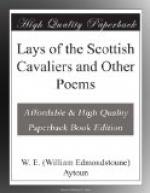“The news of their overthrow in the field of Flodden reached Edinburgh on the day after the battle, and overwhelmed the inhabitants with grief and confusion. The streets were crowded with women seeking intelligence about their friends, clamouring and weeping. Those who officiated in absence of the magistrates proved themselves worthy of the trust. They issued a proclamation, ordering all the inhabitants to assemble in military array for defence of the city, on the tolling of the bell; and commanding, ’that all women, and especially strangers, do repair to their work, and not be seen upon the street clamorand and cryand; and that women of the better sort do repair to the church and offer up prayers, at the stated hours, for our Sovereign Lord and his army, and the townsmen who are with the army.’”
Indeed the council records bear ample evidence of the emergency of that occasion. Throughout the earlier pages, the word “Flowdoun” frequently occurs on the margin, in reference to various hurried orders for arming and defence; and there can be no doubt that, had the English forces attempted to follow up their victory, and attack the Scottish capital, the citizens would have resisted to the last. But it soon became apparent that the loss sustained by the English was so severe, that Surrey was in no condition to avail himself of the opportunity; and in fact, shortly afterwards, he was compelled to disband his army.
The references to the city banner, contained in the following poem, may require a word of explanation. It is a standard still held in great honour and reverence by the burghers of Edinburgh, having been presented to them by James the Third, in return for their loyal service in 1482. This banner, along with that of the Earl Marischal, still conspicuous in the Library of the Faculty of Advocates, was honourably brought back from Flodden, and certainly never could have been displayed in a more memorable field. Maitland says, with reference to this very interesting relic of antiquity,—
“As a perpetual remembrance of the loyalty and bravery of the Edinburghers on the aforesaid occasion, the King granted them a banner or standard, with a power to display the same in defence of their king, country, and their own rights. This flag is kept by the Convener of the Trades; at whose appearance therewith, it is said that not only the artificers of Edinburgh are obliged to repair to it, but all the artisans or craftsmen within Scotland are bound to follow it, and fight under the Convener of Edinburgh as aforesaid.”
No event in Scottish history ever took a more lasting hold of the public mind than the “woeful fight” of Flodden; and, even now, the songs and traditions which are current on the Border recall the memory of a contest unsullied by disgrace, though terminating in disaster and defeat.
EDINBURGH AFTER FLODDEN
I.




